(Watch David Zwang’s interview with Sharon Cohen, Chief Business Officer, Landa Digital Printing, here.)
Benny Landa excited the crowds at drupa 2012 with his latest venture, Landa Digital Printing, a company focused on a new printing technology called Nanography, it offered a glimpse into a new way of producing print, not as just analog or digital.
While the anticipation of this new technology was great, the Landa team realized that this was going to be a much bigger effort than any of the very experienced team expected. Ultimately there was a big spread between the concept and the execution. They realized that when you are pushing the envelope on material science, data rates, jetting rates, speed, quality, etc., there are a lot of moving parts that need to be addressed. So instead of shipping product, they went back to the labs in Rehovot, Israel, to address outstanding issues and use the feedback they received at drupa, subsequent visits to printing businesses and a few beta sites around the world, to refine the functional design.
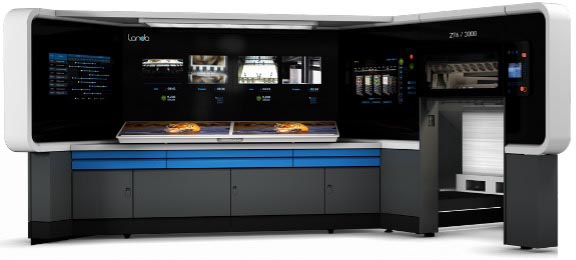
So here we are, a little over 10 years after the initial introduction of the Landa Digital Print technology. Landa has currently has about 550 employees, of which about 250 are in R&D, improving on the technology and looking toward the future. In a recent interview with Landa Digital Printing CBO, Sharon Cohen, in addition to a visit at two very different Landa press installations, I got a chance to revisit Landa, and reflect on their history and future.
It’s Not Just Another Digital or Offset Press
The Landa press technology is fairly unique. According to Cohen, “We’re not another offset. We’re not another digital. We’re somewhere in between. You can call it digital offset if like, but we offer all the benefits of digital, the variable data where every page is different, print on demand, zero makeready, low waste, and all these other features. And on top of that, with offset press productivity and speeds, and this is what we do on any paper.”
Landa Nanotechnology
Since this is the core of the press technology, it is the best place to start. If you have been following my writings on Production Inkjet, you know that there are significant obstacles to overcome in order to reach the ultimate goal of offset replacement. Probably the most challenging is getting ink to adhere to, and sit on the top surface of, the media. Of course, the main problem is that inkjet inks have a liquid carrier component, whether they are water or solvent-based. To date, we have seen press manufacturers primarily focus on preparing the media, either through treatment at media manufacturing or pre-treatment as a flood or spot coat in line with the print engine. Or in the case of solvent inks, they are using UV light and/or heat to evaporate the liquids and quickly set the ink on the media.
The challenge here is all of the cut sheet production inkjet presses currently in the market spray drops of ink directly on the surface of the media as it passes by the heads. First of all, imagine trying to get drops of water to an fall on an exact spot on moving media. Especially when those drops are very light, and there is an airflow created between the moving media and the printheads. And if you add the air pushed by the front edge of each sheet to that mix, you can see it is even more complex with cut sheet than trying to do it on a web of paper. Additionally, when the wet ink lands on the paper it gets absorbed into the paper, which affects print quality and drying.
Imaging
The Landa Nanographic Printing® process was designed to address those issues, and it does it in a very unique and creative way. It starts with a specially designed version of the Fujifilm Dimatix SAMBATM piezoelectric drop on demand (DoD) printheads with a native resolution of 1,200 x 1,200 dpi with four levels of grey scale. The Fujifilm Dimatix heads deliver a minimum dot size of two picoliters, which makes for a much smoother looking offset-like print.
The water-based ink for this process is manufactured in Israel, Europe, and soon in the US by Landa Digital Printing. While most of the inkjet manufacturers use nano grinds of pigment in their inks at this point, the unique qualities of Landa NanoInk® provide unusually powerful colorants. Landa ships the base press configuration with four colors (CMYK) with a gamut that achieves about 85% of the Pantone® range. It can be configured with up to seven colors (CMYKOGB) which achieves about 96% of the Pantone range.
The Nanographic prints have achieved TÜV AUSTRIA’s “OK Compost INDUSTRIAL” and “OK Compost HOME” certifications, demonstrating waste reduction and countering the negative impact printing can have on the environment. Since one of the areas of focus for the technology is packaging, Landa made sure the inks meet FDA and EU regulations for food contact (indirect) , and the BRC/IOP Global Standard for Packaging and Packaging Materials, amongst others.
Offset Transfer
In addition to the ink characteristics, Landa uses a unique imaging approach, jetting the ink onto a heated transfer blanket, drying the ink on the blanket and then transferring the dried image to the media. By jetting the ink onto the specially designed transfer blanket, they are able to overcome the inability of inkjet’s adherence of the ink to a variety of media surfaces. The abrasion-resistant laminated layer is then transferred onto virtually any paper or plastic without penetrating the surface, leaving no residual ink on the blanket. The image instantly bonds with the media and since there is no water at that point, the image can bond to almost any media, and reduces the speed constraints experienced by the other cutsheet production inkjet vendors.

Quality
The quality of the print is also affected by this process because there is no surface penetration as in inkjet or spread as in conventional offset. This provides a level of clarity and detail not available in either of those technologies, regardless of resolution.
Following are some dot comparisons that make it very easy to see how this process improves the dot structure on different media.
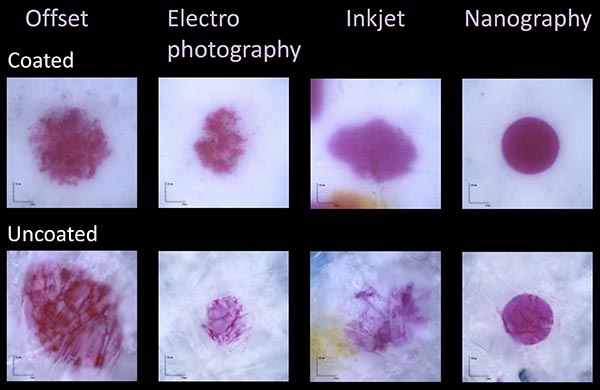
As you can see, there is a distinct sharpness to the nanographic dots that should translate into finer lines, sharper images with more visible detail, and perhaps even higher print contrast.
Software Is Integral
When you look at the DFE (Digital Front End) of digital and now even offset presses, they perform a few functions. They process the incoming files and send it to the imaging engine. While today’s DFEs can offer some additional control of the print hardware, in the case of Landa, this is tightly integrated from the workflow to the press functions. In essence it is computer driven.
Landa has partnered with EFI to develop and supply the DFE for its presses. While EFI has been developing and integrating its Fiery DFEs into digital printers for years, the demands of the Landa presses presented lots of new challenges. The essence of these challenges, is that the data storage and RIP processing demands of these presses push the limits of the state of currently available technology.
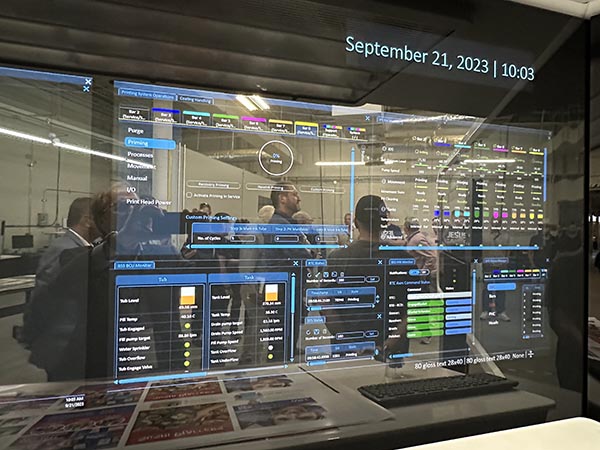
Like most computers, the Landa Press software can be updated, and according to Cohen, “we’re now upgrading the presses every month, in many cases seamlessly in the background, so people don’t need to wait that long to have 20 issues addressed, but they can wait a month and have five solved and so on. That changed the time for improvements in the field. That includes updating Landa’s Active Quality Management (AQM), an inline, closed loop quality control system with automatic correction for registration, nozzle failures, etc.
Transport and Press Configurations
The media transport for Landa presses was jointly designed by Landa and Komori, and it is manufactured by Komori. This approach makes a lot of sense, since Komori has been producing presses since 1925. This translates into a paper feed, transport, and delivery system design based on lots of experience over many years. It also allows Landa to focus on the unique imaging technology. All Landa presses have the same imaging system.
The two currently available press models are of B1 press size. The S10 simplex press is designed for folding cartons, POP applications, etc.; and the S10P is a perfecting model designed for general commercial print applications, although I have been to six installations and, as is usually the case, the printers and converters are defining their own use for each. They both support a maximum sheet size of 29.5 x 41.3 in., and a maximum print area of 28.7 x 40.6 in. The presses support a wide range of media type and thickness. The presses are rated at 6,500 sheets per hour (sph) simplex and 3,250 sph duplex. There is an optional coating unit that supports both flood and spot coats, and both UV and aqueous coatings.
It’s About the Relationship
Sometimes it’s not easy for people to grasp what is it that Landa offers and what makes them different. They don’t understand how dramatic the change can be for them having this press installed vs. another type, yet they can be installed right next to each other.
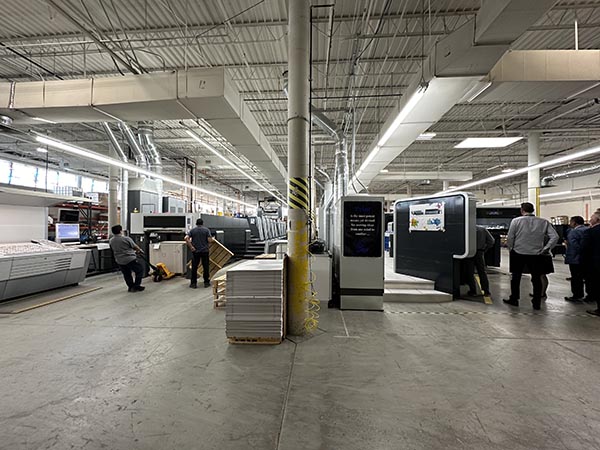
The exclusive imaging and software, combined with the unique uses like running variable data in very high speeds on large formats that requires faster ripping can present challenges to their customers. In turn, that creates challenges for Landa to “help overcome with our customers.” This technology opens new markets and new boundaries all the time. To address this, said Cohen, they, “assigned FSEs (field service engineers) to our customers and assign an account SM (success manager), at no additional charge, until the customer felt confident to run solo. While the field service engineers are focused on keeping the press running, making sure that people are trained, that they have first line of support, the account success managers are basically overseeing the performance of the technology at the site.” In other words, to make sure that the customer is successful.
“We treat every customer almost as a project,” Cohen added. “There’s continuous feedback of, hey, we tried that in other places, so let’s try this here to see how it works, and can we learn from what you guys did?” These tighter relationships and the customer centric approach also trickles down to R&D. Since they now have a regular eye into the customer, and how they are, or would like to be, using the press it has enabled them to address customer issues more quickly.
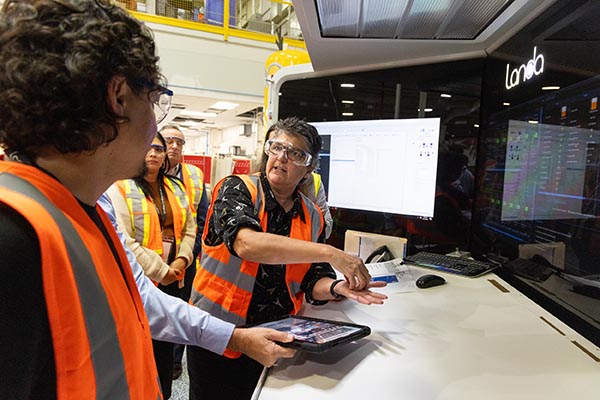
© Brian Lawler
Their model for scaling to the growth is based on building a cluster of a service organization in the sub region. As their customer base grows, it is necessary to scale the staffing, and it seems that the service organizations supporting these increasing installations are growing very nicely as well. “We always try harder, and we are getting much better at what we do,” said Cohen. “There will be challenges and there will be problems that needs to be addressed. But I can say that we’re building a very, very, very good and dedicated team.” For example, in Dallas up until a year ago, they had only one customer, Virtual Packaging. Today they have four, three of them are already installed, including Southern Champion Tray and Broadnax.
“So we have created that cluster there, and now we’re servicing more accounts,” said Cohen. “Same goes for LA where we currently have three accounts, and so on in other regions in the country. So, we are thinking about scalability. We’re trying to build it in a smart way to develop, and to keep that personal relationship. Because at the end of the day, it’s all about people, and it’s all about commitment. And I would dare to say personal commitment to make it a success when a company makes that investment in technology, whether that be Landa or another one.”
I recently visited Broadnax outside of Dallas, Tex.. It’s a recent installation and they were printing production from day one. So, it seems like they are doing something right with their customers.
Conclusion and Futures
Today there are over 40 machines installed, six installations coming up in the next three months, and right after that almost a another dozen and more in the pipeline. These presses are distributed across North America, Latin America, Europe, and Asia Pacific. Currently the distribution is split between S10 and S10P presses that are successfully used to produce commercial print and packaging every day. Landa Digital Printing currently has about 550 employees of which about 250 are in R&D, constantly improving on the technology and looking toward the future.
While not yet available, the Landa W10 is a continuous webfed model that was introduced during drupa 2012 and is still under development at this point. We look forward to seeing it and other innovations.
More to Come…
2023 is moving at an increased pace, with drupa 2024 beginning to shine its light. I would like to address your interests and concerns in future articles as it relates to the manufacturing of Print, Packaging, and Labels, and how, if at all, it drives future workflows including “Industry 4.0.” If you have any interesting examples of hybrid and bespoke manufacturing, I am very anxious to hear about them. Please feel free to contact me at [email protected] with any questions, suggestions, or examples of interesting applications.










Discussion
By Eddy Hagen on Oct 12, 2023
Is there a list of the 'over 40' installments? Was this checked?
I've followed every Landa Nano press release, every post on LinkedIn and X (Twitter) and have only seen 30 sales or installments. Given the amount of publicity they attribute to every sale and installments, it would be a bit surprising if they had over 10 installments they didn't 'brag' about...
This is the list I've compiled over the years: https://www.insights4print.ceo/2020/01/drupa-2020-what-you-will-see-in-dusseldorf/#LandaInstallments
And it also includes one case where the press has been removed.
By David L. Zwang on Oct 12, 2023
Eddy they validated the numbers and I am in no position to pass the information on
Discussion
Join the discussion Sign In or Become a Member, doing so is simple and free